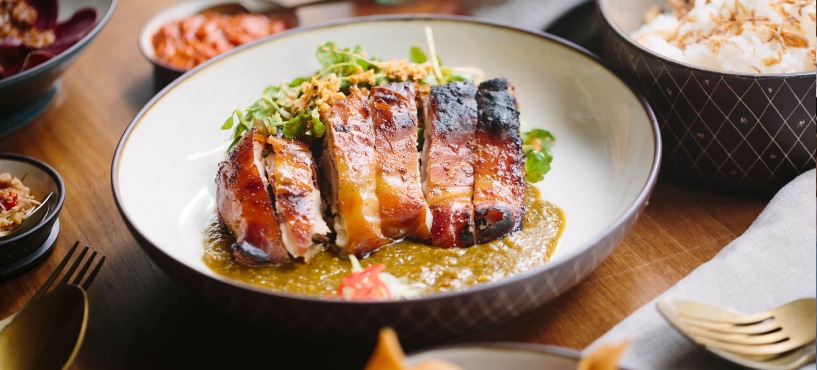Babi Guling, or Balinese roast pig, is not just a dish; it’s a culinary tradition deeply embedded in the cultural and social fabric of Bali. This succulent, flavorful roast pig has become synonymous with Balinese cuisine, attracting both locals and tourists alike. This article delves into the history, preparation, cultural significance, and contemporary relevance of Babi Guling in Bali.
Introduction
Bali, an Indonesian island known for its rich cultural heritage and stunning landscapes, boasts a diverse culinary scene. Among its myriad of traditional dishes, Babi Guling stands out as a must-try delicacy. This article explores the origins, preparation methods, and cultural importance of Babi Guling, providing a comprehensive understanding of this iconic dish.
History of Babi Guling
The history of Babi Guling in Bali is intertwined with the island’s religious and cultural practices. Traditionally, Babi Guling was prepared for special ceremonies and religious festivals, reflecting its deep-rooted significance in Balinese culture.
Origins
- Ceremonial roots: Babi Guling was originally cooked for temple ceremonies, family celebrations, and village festivals, symbolizing prosperity and offering to the gods.
- Royal connections: Historically, it was a dish reserved for Balinese royalty and the elite, indicating its esteemed status.
Evolution Over Time
Over the years, Babi Guling has evolved from a ceremonial dish to a popular food enjoyed by locals and tourists alike. While it retains its cultural significance, it is now readily available in many warungs (local eateries) and restaurants across Bali.
Preparation of Babi Guling
The preparation of Babi Guling is an art form that involves meticulous steps and traditional techniques passed down through generations. The process is labor-intensive and requires a high level of skill to achieve the perfect balance of flavors and textures.
Ingredients
The main ingredients for Babi Guling include:
- A whole pig, typically a young and tender suckling pig.
- Aromatic spices and herbs such as turmeric, garlic, shallots, lemongrass, galangal, and kaffir lime leaves.
- Special spice paste, known as bumbu bali, made from a blend of traditional Balinese spices.
Cooking Process
The cooking process of Babi Guling involves several key steps:
- Preparation: The pig is cleaned thoroughly, and the spice paste is prepared by grinding fresh spices into a thick mixture.
- Stuffing and marinating: The spice paste is generously stuffed inside the pig and rubbed all over the skin, ensuring the flavors penetrate the meat.
- Roasting: The pig is slowly roasted over an open flame or in a traditional wood-fired oven, turned regularly to ensure even cooking and crispy skin. The roasting process can take several hours.
Serving
Once cooked, Babi Guling is typically served with a variety of accompaniments:
- Lawar: A traditional Balinese salad made with vegetables, grated coconut, and spices, sometimes mixed with minced meat or blood.
- Sambal: A spicy chili paste that adds an extra kick to the dish.
- Rice: Steamed rice is a staple side dish that complements the rich flavors of Babi Guling.
Cultural Significance
Babi Guling is more than just a meal; it is a symbol of Balinese heritage and communal harmony. Its preparation and consumption are deeply rooted in the island’s traditions and rituals.
Religious and Ceremonial Importance
Babi Guling holds a special place in Balinese Hindu ceremonies. It is often prepared for:
- Temple offerings: As a sacred offering to the gods during temple festivals and religious rites.
- Family celebrations: During important family milestones such as weddings, funerals, and birthdays.
- Village festivals: To foster community spirit and celebrate local customs and traditions.
Symbol of Prosperity and Unity
The communal preparation and sharing of Babi Guling symbolize prosperity, gratitude, and social unity. It is a dish that brings people together, reinforcing the bonds of family and community.
Babi Guling in Modern Bali
In contemporary Bali, Babi Guling has transcended its ceremonial origins to become a beloved dish enjoyed by all. It is a staple in Balinese cuisine and a major attraction for food enthusiasts visiting the island.
Popular Restaurants and Warungs
Several renowned establishments serve exceptional Babi Guling:
- Ibu Oka: Perhaps the most famous Babi Guling restaurant, located in Ubud, known for its tender meat and crispy skin.
- Babi Guling Pak Malen: A popular spot in Seminyak, celebrated for its flavorful and authentic preparation.
- Babi Guling Candra: Located in Denpasar, this warung is famous among locals for its traditional taste and generous portions.
Tourist Attraction
Babi Guling has become a significant draw for culinary tourism in Bali. Food tours often highlight this dish, allowing visitors to experience its rich flavors and cultural context.
Adaptations and Innovations
Modern chefs and food entrepreneurs in Bali are experimenting with Babi Guling, creating innovative variations while respecting traditional methods. These adaptations include:
- Babi Guling burgers: A fusion of traditional flavors with contemporary fast food.
- Vegan and vegetarian versions: Using plant-based ingredients to replicate the flavors for those with dietary restrictions.
Challenges and Future Trends
While Babi Guling remains a cherished part of Balinese culture, it faces certain challenges and opportunities for evolution.
Health and Sustainability Concerns
With increasing awareness of health and environmental issues, there is a growing emphasis on sustainable and health-conscious culinary practices. Efforts are being made to source pork responsibly and promote balanced consumption.
Preserving Tradition
Maintaining the authenticity of Babi Guling amidst modern influences is crucial. Initiatives to document traditional recipes and cooking techniques are essential to preserve this culinary heritage.
Global Influence
The popularity of Babi Guling is spreading beyond Bali, with international chefs and food enthusiasts showing interest in this unique dish. This global exposure presents opportunities for cultural exchange and culinary innovation.
Conclusion
Babi Guling is more than just a roast pig; it is a symbol of Balinese culture, tradition, and communal harmony. From its ceremonial roots to its modern-day popularity, this dish embodies the rich culinary heritage of Bali. As the island continues to attract food lovers from around the world, Babi Guling remains a testament to Bali’s vibrant and evolving culinary landscape. By honoring traditional methods while embracing contemporary trends, Babi Guling will continue to captivate and delight future generations.





